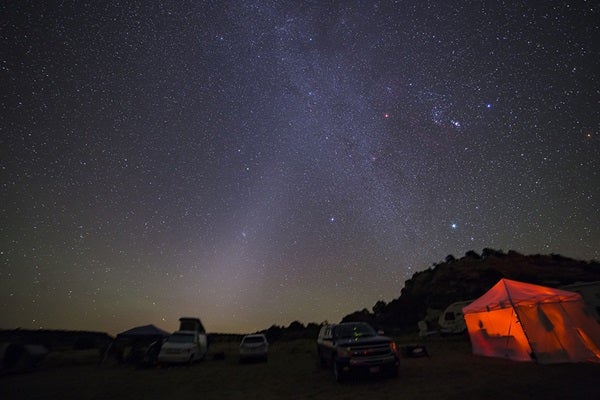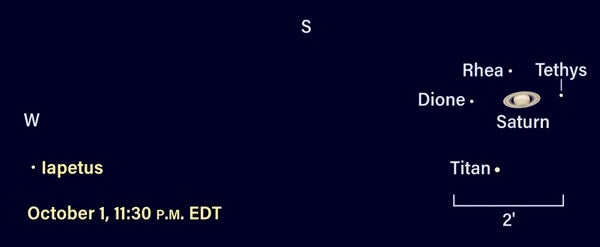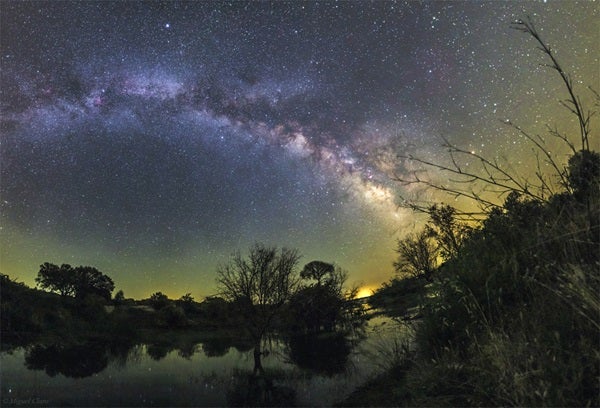Neptune appeared at its best at opposition earlier this month, but its visibility hardly suffers this week. The outermost major planet lies in the southeastern sky once darkness falls and climbs highest in the south around midnight local daylight time. Neptune glows at magnitude 7.8, which is bright enough to spot through binoculars if you know where to look. The trick is to find the 4th-magnitude star Phi (φ) Aquarii, which lies about 15° (two binocular fields) east-southeast of Aquarius’ distinctive Water Jar asterism. Tonight, Neptune appears just 0.6° west-southwest of Phi. When viewed through a telescope, the ice giant planet shows a blue-gray disk measuring 2.4″ across.
The Moon reaches perigee, the closest point in its orbit around Earth, at 10:24 p.m. EDT. It then lies 222,328 miles (357,802 kilometers) away from us.
Saturday, September 28
New Moon occurs at 2:26 p.m. EDT. At its New phase, the Moon crosses the sky with the Sun and so remains hidden by our star. Because the Moon reached its closest point to Earth yesterday evening, residents in coastal areas can expect higher than normal tides for the next few days.
The Moon’s absence from the morning sky these next two weeks provides observers with an excellent opportunity to view the zodiacal light. From the Northern Hemisphere, the time around the autumnal equinox is the best for viewing the elusive glow before sunrise. It appears slightly fainter than the Milky Way, so you’ll need a clear moonless sky and an observing site located far from the city. Look for a cone-shaped glow that points nearly straight up from the eastern horizon shortly before morning twilight begins (around 5:30 a.m. local daylight time at mid-northern latitudes). The Moon remains out of the morning sky until October 12, when the waxing gibbous returns and overwhelms the much fainter zodiacal light.
Sunday, September 29
The variable star Algol in Perseus reaches minimum brightness at 12:34 a.m. EDT tomorrow morning. Observers on the East Coast who start watching around midevening can see the star’s brightness diminish by 70 percent over the course of about five hours. Those in western North America will see Algol brighten noticeably from late evening until dawn starts to paint the sky, when the star stands high in the west. This eclipsing binary system runs through a cycle from minimum (magnitude 3.4) to maximum (magnitude 2.1) and back every 2.87 days.
Monday, September 30
The dwarf planet Ceres reached opposition in May, but it remains a tempting target in the evening sky thanks to its proximity to two much brighter objects. This evening, Ceres lies midway between brilliant Jupiter and 1st-magnitude Antares, the brightest star in Scorpius the Scorpion. Even better, the 9th-magnitude dwarf planet currently stands in front of a star-poor dust lane in the otherwise rich Milky Way background. Identifying Ceres from the suburbs should be fairly easy through a small telescope, and those blessed with dark skies should be able to spot it through binoculars.
Although magnificent Saturn reached its peak in July, our view of the ringed planet remains spectacular. It resides among the background stars of Sagittarius the Archer, a region that appears nearly 30° above the southern horizon an hour after sundown and doesn’t set until midnight local daylight time. Saturn continues to shine brightly, too, at magnitude 0.5. When viewed through a telescope, the planet’s disk measures 17″ across while the dramatic ring system spans 38″ and tilts 25° to our line of sight. Tonight is also a good night to hunt for its five brightest moons. You’ll find 8th-magnitude Titan and the 10th-magnitude trio of Tethys, Dione, and Rhea clustered relatively close to the planet. Distant Iapetus is a bit harder to locate. Fortunately, it reaches greatest western elongation tonight, when its brighter hemisphere faces Earth and it glows brightest (at 10th magnitude). Look for Iapetus 8.5′ west of Saturn.
Wednesday, October 2
Tonight marks the unofficial start of the annual Orionid meteor shower. Although the Orionids won’t peak for nearly three weeks (before dawn October 22), you should start to see a few shower members in the early morning hours. The next 10 days offer Moon-free observing before dawn, something the waning Moon will prevent at the shower’s peak. Orionid meteors appear to radiate from the northern part of the constellation Orion the Hunter.
Thursday, October 3
The waxing crescent Moon lies just 2° to Jupiter’s upper left this evening. The night sky’s two brightest objects appear above the southwestern horizon as twilight fades to darkness and don’t set until 10 p.m. local daylight time. Of course, the planet remains a beacon all week, gleaming at magnitude –2.0. When viewed through a telescope, Jupiter shows a 36″-diameter disk with striking details in its dynamic atmosphere. You also should see four bright points of light arrayed around the planet: the Galilean moons Io, Europa, Ganymede, and Callisto.
Although autumn began last week and the stars of winter’s Orion now rule the morning sky, the Summer Triangle remains prominent on early October evenings. Look high in the west after darkness falls and your eyes will fall on the brilliant star Vega in the constellation Lyra the Harp. At magnitude 0.0, Vega is the brightest member of the triangle. The second-brightest star, magnitude 0.8 Altair in Aquila the Eagle, lies some 35° southeast of Vega. The asterism’s dimmest member, magnitude 1.3 Deneb in Cygnus the Swan, stands about 25° east-northeast of Vega. For observers at mid-northern latitudes, Deneb passes through the zenith around 9 p.m. local daylight time, about an hour after the last vestiges of twilight disappear.
Saturday, October 5
First Quarter Moon arrives at 12:47 p.m. EDT. Our satellite rises in the southeast around 2:30 p.m. local daylight time, but it doesn’t become prominent until the Sun sets shortly before 7 p.m. (The Moon then lies due south and about one-third of the way to the zenith.) After darkness falls, the Moon’s half-lit orb appears in northern Sagittarius, above the handle in that constellation’s conspicuous Teapot asterism. The Moon also serves as a guide for finding Saturn this evening. The ringed planet is the bright point of light just a couple of degrees to Luna’s right.
Sunday, October 6
Observers of the outer solar system can get good views of Uranus during the late evening hours. The ice giant planet rises during twilight, and it climbs nearly halfway to the zenith in the east-southeast by 11 p.m. local daylight time. It reaches its peak some 60° above the southern horizon around 2 a.m. Uranus glows at magnitude 5.7 against the backdrop of southern Aries the Ram. Use binoculars to find the planet 2.5° due south of the similarly bright star 19 Arietis. A telescope reveals Uranus’ blue-green disk, which spans 3.7″. To learn more about viewing Uranus and its outer solar system cousin, Neptune, see “Observe the ice giants” in October’s Astronomy.












